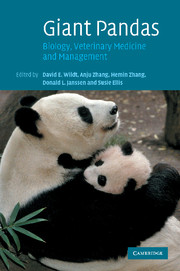Book contents
- Frontmatter
- Contents
- List of contributors
- Foreword
- Acknowledgements
- 1 The giant panda as a social, biological and conservation phenomenon
- 2 The Giant Panda Biomedical Survey: how it began and the value of people working together across cultures and disciplines
- 3 Factors limiting reproductive success in the giant panda as revealed by a Biomedical Survey
- 4 Significant medical issues and biological reference values for giant pandas from the Biomedical Survey
- 5 Life histories and behavioural traits as predictors of breeding status
- 6 Nutrition and dietary husbandry
- 7 Male reproductive biology in giant pandas in breeding programmes in China
- 8 Endocrinology of the giant panda and application of hormone technology to species management
- 9 The value and significance of vaginal cytology
- 10 Parentage assessment among captive giant pandas in China
- 11 The science of behavioural management: creating biologically relevant living environments in captivity
- 12 Evaluating stress and well-being in the giant panda: a system for monitoring
- 13 The neonatal giant panda: hand-rearing and medical management
- 14 Consequences of early rearing on socialization and social competence of the giant panda
- 15 Medical management of captive adult and geriatric giant pandas
- 16 Diseases and pathology of giant pandas
- 17 Ultrasonography to assess and enhance health and reproduction in the giant panda
- 18 Gastrointestinal endoscopy in the giant panda
- 19 Historical perspective of breeding giant pandas ex situ in China and high priorities for the future
- 20 Role and efficiency of artificial insemination and genome resource banking
- 21 Analysis of demographic and genetic trends for developing a captive breeding masterplan for the giant panda
- 22 Partnerships and capacity building for securing giant pandas ex situ and in situ: how zoos are contributing to conservation
- Index
- Plate Section
- References
1 - The giant panda as a social, biological and conservation phenomenon
Published online by Cambridge University Press: 09 August 2009
- Frontmatter
- Contents
- List of contributors
- Foreword
- Acknowledgements
- 1 The giant panda as a social, biological and conservation phenomenon
- 2 The Giant Panda Biomedical Survey: how it began and the value of people working together across cultures and disciplines
- 3 Factors limiting reproductive success in the giant panda as revealed by a Biomedical Survey
- 4 Significant medical issues and biological reference values for giant pandas from the Biomedical Survey
- 5 Life histories and behavioural traits as predictors of breeding status
- 6 Nutrition and dietary husbandry
- 7 Male reproductive biology in giant pandas in breeding programmes in China
- 8 Endocrinology of the giant panda and application of hormone technology to species management
- 9 The value and significance of vaginal cytology
- 10 Parentage assessment among captive giant pandas in China
- 11 The science of behavioural management: creating biologically relevant living environments in captivity
- 12 Evaluating stress and well-being in the giant panda: a system for monitoring
- 13 The neonatal giant panda: hand-rearing and medical management
- 14 Consequences of early rearing on socialization and social competence of the giant panda
- 15 Medical management of captive adult and geriatric giant pandas
- 16 Diseases and pathology of giant pandas
- 17 Ultrasonography to assess and enhance health and reproduction in the giant panda
- 18 Gastrointestinal endoscopy in the giant panda
- 19 Historical perspective of breeding giant pandas ex situ in China and high priorities for the future
- 20 Role and efficiency of artificial insemination and genome resource banking
- 21 Analysis of demographic and genetic trends for developing a captive breeding masterplan for the giant panda
- 22 Partnerships and capacity building for securing giant pandas ex situ and in situ: how zoos are contributing to conservation
- Index
- Plate Section
- References
Summary
INTRODUCTION
The giant panda has captured the world's imagination. Its seemingly harmless, playful nature, velvety black and white fur, flat face, softly rounded body and soulful black eye patches combine to make it resemble an oversized and loveable teddy bear (Fig. 1.1). Its upright posture and famous ‘panda's thumb’ – an elongation of the wrist bone that allows it to grasp bamboo and other food much like people do – further adds to its widespread appeal. From the most prominent government authorities to young children, people are passionate about protecting the giant panda. This fervent interest has caused the panda to emerge as the most highly visible of all endangered species, even though few people have actually ever seen one in the wild. Furthermore, this single species has become a worldwide icon for the need to conserve animals, plants and habitats. Therefore, it is ironic that the giant panda, which evokes so much attention by the public, scientific and conservation communities, still remains such a mystery with so many pieces still missing from a biological jigsaw puzzle that, if solved, could improve species management, welfare and conservation. The purpose of this book is to provide, and then assemble, a few more pieces of this enormous puzzle.
WHY THE GIANT PANDA IS UNIQUE AMONG SPECIES, ESPECIALLY BEARS
Within China, the giant panda often is called daxiongmao by local people, literally ‘large bear-cat’ in Chinese (Schaller et al., 1985). Its scientific name Ailuropoda melanoleuca actually means black and white cat-footed bear.
- Type
- Chapter
- Information
- Giant PandasBiology, Veterinary Medicine and Management, pp. 1 - 16Publisher: Cambridge University PressPrint publication year: 2006
References
- 7
- Cited by

